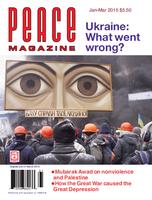
Peace Magazine Jan-Mar 2015, page 15. Some rights reserved.
Search for other articles by George Yu here
As I write from Hong Kong, where the “Occupy Central,” (or “Umbrella”) movement began in September. Many call it a “color revolution”—a pro-democracy movement initiated by the public, while others regard it as a campaign that undermines the rule of law.
The movement was initiated by Benny Tai Yiu-Ting (a law professor at the University of Hong Kong) , Reverend Chu Yiu-ming, and Mr. Chan Kin-man. They proposed a civil disobedience action in Central, the business and financial centre of Hong Kong, if the government adopted a “fake” democracy instead of the proposed electoral reforms. They called this “Occupy Central with Love and Peace.” The protest was to be held on October 1, Chinese National Day.
But on August 31, China’s Standing Committee of the National People’s Congress announced its rejection of the reforms. They ruled that a 1200-member nominating committee would elect two to three candidates before the general public could vote on them. That way, the Beijing regime could filter out its potential opponents.
Before the movement even began, many considered that it had been hijacked by students. University students boycotted classes from 22 to 26 September and secondary school students on 26 September. By that weekend their boycott had evolved into the 2014 Hong Kong protests in which several regions across the Victoria Harbour were occupied by pro-democracy protesters. A few students were arrested and released; others were urging the original Occupy Central to start an occupy movement. Responding to pressure, Professor Benny Tai announced the official start of Occupy Central at a midnight student protest outside Hong Kong’s government headquarters.
By that night, the police had used tear gas, pepper spray, and batons to disperse the crowd. However, the excessive use of force further antagonized people. Thousands more began to occupy other major areas of Hong Kong including Mong Kok and Causeway Bay. By Monday, the government withdrew the riot police and diverted buses and vehicles, creating massive traffic problems.
The protesters were a self-organizing community without any leader, but with teams of volunteers working in shifts to deal with garbage collection, recycling, security, and medical care. There were plenty of supply stations giving out water, fresh fruit, toilet paper, saline solution, instant coffee, masks, goggles, cereal bars, and umbrellas—all free of charge. At one location there were more than 200 volunteers. Wooden steps were built to allow people to cross over the central divide of the eight-lane road in Admiralty. Mobile phone charging stations were powered by an electric generator and a study area was created, complete with desk lamps and wi-fi.
The underlying reasons for their protests were the social and economic issues since Hong Kong had reverted to China in 1997. After the handover, the Beijing Government truly took a hands-off approach toward Hong Kong, accepting the “one country, two systems” model. However, the imcompentence of the Hong Kong government rankled.
The first major protest happened on July 1, 2003 when 500,000 gathered to oppose the anti-subversion Basic Law Article 23, fearing the loss of freedom of speech and other freedoms. They were also dissatisfied with the Hong Kong government’s handling of the Asian financial crisis in 1998 and SARS crisis in 2003. The Hong Kong government withdrew the Basic Law Article 23 and averted the crisis.
Since 2003, the Hong Kong government itself requested Beijing’s economic and political support and in turn gave Beijing more influence over the daily affairs of Hong Kong. When President Xi became China’s leader, he drew a harder line in dealing with Hong Kong. Now Beijing and Hong Kong’s government refuse to back down. For weeks, many prominent democratic intellectuals had been predicting that Beijing’s government would be tougher toward Hong Kong. It is clear now: The “one country, two systems” policy will focus on the “one country” aspect.
Over two months, there were several incidents of violence, and the crowd of protesters dwindled. The end came on December 11, when the police began clearing the streets. The protesters had stored their supplies in warehouses to await the next confrontation.
George Yu is a Canadian Hong Konger.

Peace Magazine Jan-Mar 2015, page 15. Some rights reserved.
Search for other articles by George Yu here